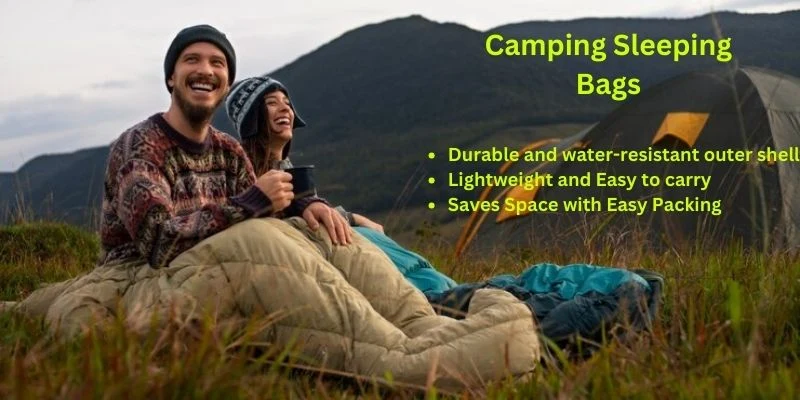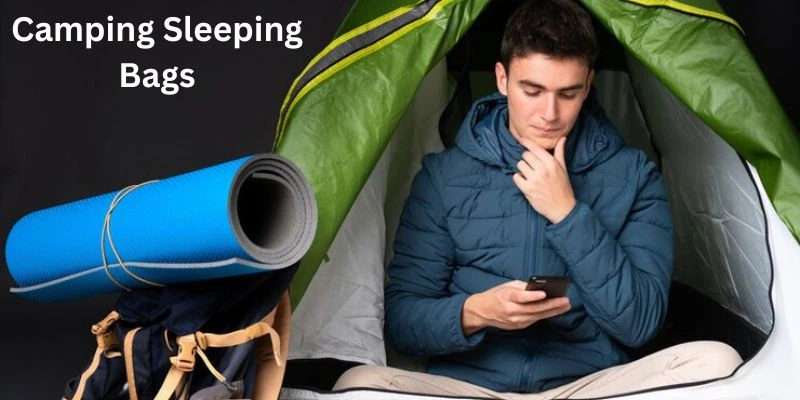5 Tips for Choosing Camping Sleeping Bags for Your Next Trip
Updated: 8 Mar 2024
200
Imagine this: a crackling campfire, a sky full of twinkling stars, and you snuggled up in a warm and comfy sleeping bag. That’s the magic of camping! But with all sorts of sleeping bags out there, choosing the right one can feel overwhelming.
Whether you’re new to camping or a pro, one thing you need to get right is your sleeping bag. Our guide covers everything about camping sleeping bags, from picking the perfect one for you to staying easy on chilly nights. We’ve got all the tips and tricks you need to make sure your camping trip is comfy and memorable. Don’t worry, this guide will help you pick the perfect sleeping bag for your next adventure.
Features of Camping Sleeping Bags
When it comes to camping, one of the essential pieces of gear you’ll need for a good night’s sleep is a reliable sleeping bag. But with so many options out there, how do you know which one is right for you? Let’s break down the key features to look for when selecting the perfect camping sleeping bag.
1. Durable and water-resistant outer shell
The outer shell of our camping sleeping bags is made from rugged materials that can withstand rough outdoor conditions. It’s also water-resistant, meaning it can repel moisture and keep you dry even if it’s damp outside.

2. Lightweight and Easy to carry
For a sleeping bag that is lightweight and easy to carry, especially if you plan on hiking to your campsite. A lightweight sleeping bag won’t weigh you down, allowing you to enjoy your outdoor adventures without feeling burdened by heavy gear.
3. Keeps you warm without weighing you Down
Choose a sleeping bag with superior insulation technology that provides warmth without adding extra bulk. This means you can stay comfortable on chilly nights without feeling like you’re carrying a heavy blanket around with you.
4. Saves Space with Easy Packing
Consider a sleeping bag with a compressible design that allows you to pack it down into a compact size. This not only saves valuable space in your backpack but also makes it easier to transport your gear to and best campsite in Nice trip.
5. Designed for Maximum Comfort
Lastly, prioritize comfort when choosing a camping sleeping bag. Look for features such as soft and breathable materials, ergonomic design, and ample room to move around. A comfortable sleeping bag ensures that you wake up feeling refreshed and ready for another day of adventure.
The durability and versatility of this camping sleeping bag exceeded my expectations. Whether I’m camping in the mountains or by the beach, it’s always my go-to choice.Emily Rodriguez, Wilderness Explorer
Sleeping Bag Shape
When it comes to sleeping bags, one of the key factors to consider is the shape. The shape of a sleeping bag can greatly affect its comfort, warmth, and suitability for different camping situations. Let’s have a deep look into the two main shapes: rectangular and mummy.
1. Rectangular Sleeping Bags
- Description: Rectangular sleeping bags are spacious and roomy, resembling a large blanket. They offer plenty of space to move around and stretch out comfortably.
- Comfort: These sleeping bags provide a more relaxed and open sleeping experience, making them ideal for campers who prefer to have freedom of movement while sleeping.
- Versatility: Due to their roomy design, rectangular sleeping bags are well-suited for car camping trips where weight and size are not major concerns. They are also popular among individuals who tend to shift positions frequently during sleep.
- Temperature Regulation: While rectangular sleeping bags offer ample space, they may not provide the same level of insulation as more snugly fitting designs. As a result, they may not be as efficient in retaining body heat in colder conditions.
- Ideal Use: Rectangular sleeping bags are excellent for car camping adventures, sleepovers, or camping trips where comfort and space are prioritized overweight and packability.
2. Mummy Sleeping Bags
- Description: Mummy sleeping bags are designed to closely resemble the shape of a cocoon, with a tapered profile that narrows towards the feet and a fitted hood that covers the head.
- Warmth: The snug fit of mummy sleeping bags minimizes the air space inside, which enhances thermal efficiency and helps retain body heat. This makes them ideal for camping in colder climates or at higher elevations.
- Weight and Packability: Mummy sleeping bags are typically lighter and more compact than their rectangular counterparts, making them a popular choice among backpackers and minimalist campers who prioritize weight savings and packability.
- Limited Mobility: The comfort of mummy sleeping bags restricts movement to some extent, which may be uncomfortable for individuals who prefer more freedom to move around while sleeping.
- Versatility: While mummy sleeping bags excel in colder conditions, they may feel too warm and restrictive in warmer climates. Additionally, some users may find the fitted hood constricting or claustrophobic.
- Ideal Use: Mummy sleeping bags are well-suited for backpacking trips, mountaineering expeditions, or any outdoor adventure where weight, warmth, and packability are critical considerations.

Temperature Rating
Here’s the information presented in the form of a table:
| Temperature Rating | Description | Features | Ideal Use |
| Summer (40°F and above) | Designed for warm weather camping. | Lightweight, breathable materials. | Camping during summer months with mild temperatures. |
| 3-Season (20°F to 40°F) | Versatile option for spring, summer, and fall camping. | Moderate insulation, balance of warmth and breathability. | Camping trips with variable temperatures in spring, summer, and fall. |
| Winter (0°F to 20°F) | Designed for cold nights or higher altitudes. | Heavy insulation, cold-weather features (draft tubes, hood cinches). | Winter camping or mountaineering in freezing temperatures. |
| Extreme Winter (Below 0°F) | Engineered for extreme cold conditions. | Maximum insulation, cold-weather features. | Polar expeditions, high-altitude mountaineering, subzero winter camping. |
This table provides a concise overview of the different temperature ratings of sleeping bags, their descriptions, features, and ideal use scenarios.
Differences between camping and general sleeping bags
Here’s a simplified explanation of the differences between camping and general sleeping bags:
- Camping sleeping bags are made for outdoor use, while general ones can be used indoors or outdoors. Camping bags are tougher outside to handle rough conditions, while general ones are softer inside for comfort.
- Another difference is in temperature ratings. Camping bags have ratings for different weather, from cold to warm. General ones might have a standard rating that’s not as flexible.
- Camping bags are usually smaller and lighter for easy carrying on outdoor trips. They come in different shapes like mummy or rectangular. General bags are more standard in size and shape.
- One big difference is that camping bags have a water-resistant outer layer, making them good for wet conditions. General bags might not have this feature.
- Camping sleeping bags are made for outdoor use, while general ones can be used indoors or outdoors. Camping bags are tougher outside to handle rough conditions, while general ones are softer inside for comfort.
Pros and Cons of Camping Sleeping Bags
Here are the pros and cons of camping sleeping bags:
| Pros |
|---|
|
| Cons |
|---|
|
Conclusion
Camping sleeping bags are super important for anyone who loves the outdoors. They’re easy to carry, keep you warm, and last a long time. Whether you’re camping, hiking, or just hanging out outside, they’re a comfy way to sleep. They might not be as comfortable as your bed at home, and sometimes it’s tricky to get the temperature just right, but they’re worth it. If you get a good one, it’ll make sure you stay cozy and get a good night’s sleep, so you can enjoy nature without feeling tired the next day.
FAQS
What are the different types of camping sleeping bags available?
There are several types of camping sleeping bags, including rectangular sleeping bags, mummy sleeping bags, double sleeping bags, and backpacking quilts. Each type has its own design and features suited for different camping preferences and conditions.
What is the difference between rectangular and mummy sleeping bags?
Rectangular sleeping bags offer more room to move around and are generally more comfortable, while mummy sleeping bags are more snug and provide better insulation. Mummy bags are also lighter and more compact, making them popular among backpackers.
How do I choose the right temperature rating for a camping sleeping bag?
The temperature rating of a camping sleeping bag indicates the lowest temperature at which it will keep you warm. Consider the typical weather conditions of your camping destination and choose a sleeping bag with a temperature rating slightly lower than the lowest expected temperature to ensure comfort.
Are there sleeping bags suitable for different seasons?
Yes, there are camping sleeping bags designed for different seasons. Summer sleeping bags are lightweight and suitable for warm weather, while 3-season sleeping bags provide moderate insulation for spring, summer, and fall camping. Winter sleeping bags are heavily insulated for cold temperatures, and extreme winter sleeping bags are designed for subzero conditions.
What features should I look for in a camping sleeping bag?
When choosing a camping sleeping bag, consider features such as the type of insulation (synthetic or down), the shape and size of the bag, the presence of a hood and draft collar for added warmth, and additional features like a water-resistant outer shell or zippered vents for ventilation.
How do I care for and maintain my camping sleeping bag?
To prolong the life of your camping sleeping bag, follow manufacturer instructions for cleaning and storage. Air out your sleeping bag regularly, spot clean any stains, and avoid storing it compressed for extended periods. Consider using a sleeping bag liner to keep it clean and protect against wear and tear.
Can I use a camping sleeping bag for activities other than camping?
While camping sleeping bags are primarily designed for outdoor use, they can also be used for indoor activities like sleepovers or as extra bedding for guests. However, consider the temperature rating and insulation of the sleeping bag to ensure comfort for indoor use.
Please Write Your Comments